
The Royal Armoured Corps is the armoured arm of the British Army, that together with the Household Cavalry provides its armour capability, with vehicles such as the Challenger 2 and the Warrior tracked armoured vehicle. It includes most of the Army's armoured regiments, both the Royal Tank Regiment and those converted from old horse cavalry regiments. In September 2024, it comprised fourteen regiments: ten Regular Regiments; four Army Reserve. Although the Household Cavalry Regiment provide an armoured regiment, they are not part of the RAC.
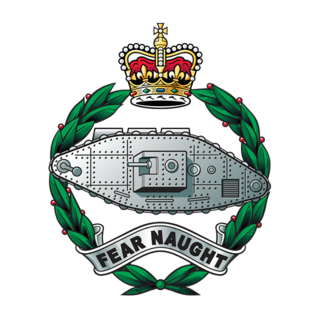
The Royal Tank Regiment (RTR) is the oldest tank unit in the world, being formed by the British Army in 1916 during the First World War. Today, it is the armoured regiment of the British Army's 12th Armoured Infantry Brigade. Formerly known as the Tank Corps and the Royal Tank Corps, it is part of the Royal Armoured Corps.

The Joint Chemical, Biological, Radiological and Nuclear Regiment was a specialist expeditionary unit of the British armed forces. Personnel of the Joint CBRN Regiment were trained in the detection, identification and monitoring of nuclear, biological and chemical weapons.
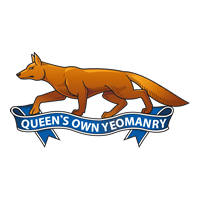
The Queen's Own Yeomanry (QOY) is one of the Army Reserve light armoured reconnaissance regiments.
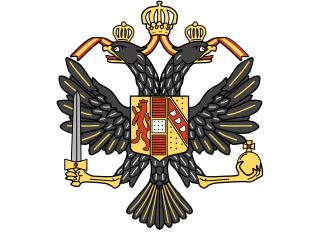
1st The Queen's Dragoon Guards (QDG) is a regiment in the Royal Armoured Corps of the British Army. Nicknamed The Welsh Cavalry, the regiment recruits from Wales and the bordering English counties of Cheshire, Herefordshire, and Shropshire, and is the senior cavalry regiment, and therefore senior regiment of the line of the British Army.

The Light Dragoons (LD) is a cavalry regiment in the British Army. The regiment has a light cavalry role and specialises in mounted and dismounted reconnaissance. The Light Dragoons recruit mainly in Northern England, from County Durham, Northumberland, Tyne and Wear, South Yorkshire and the East Riding of Yorkshire. For this reason, the regiment is known as "England's Northern Cavalry". It is currently based in Catterick Garrison, North Yorkshire.
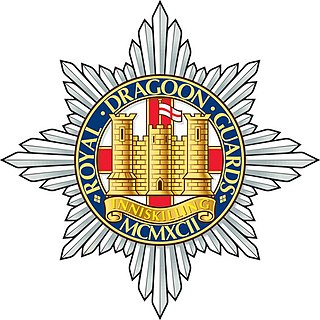
The Royal Dragoon Guards (RDG) is a cavalry regiment of the British Army. It was formed in 1992 by the amalgamation of two other regiments: The 4th/7th Royal Dragoon Guards and the 5th Royal Inniskilling Dragoon Guards. Based in Battlesbury Barracks, Wiltshire, the regiment currently serves as the armoured cavalry reconnaissance unit of 20th Armoured Brigade Combat Team. Previously equipped with the Scimitar armoured reconnaissance vehicle, it started converting to the Warrior tracked armoured vehicle in 2022.

The Sherwood Rangers Yeomanry (SRY) was a British Yeomanry regiment. In 1967 it was amalgamated with other units to form the Royal Yeomanry (RY), a light cavalry regiment of the Army Reserve. Originally raised as the Nottinghamshire Yeomanry Cavalry in 1794, the regiment was used on several occasions in the 19th century to maintain law and order. During the Second Boer War and both World Wars the regiment earned 44 battle honours. It is now one of the six squadrons of the Royal Yeomanry (RY), a light cavalry regiment of the Army Reserve. Designated as 'A' Squadron, the Sherwood Rangers Yeomanry's current role is to support the Light Cavalry Regiments on operations by providing reconnaissance soldiers.
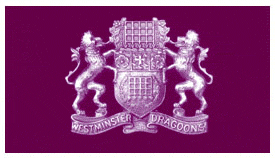
The Westminster Dragoons (WDs) was a yeomanry regiment of the British Army Army Reserve, located in central London. Its lineage is continued by one of the Royal Yeomanry's six squadrons. Formed in the aftermath of Second Boer War as part of the County of London Yeomanry, the WDs fought in the Battle of Gallipoli and led British forces onto the beaches during the Normandy Invasion in 1944. The squadron most recently saw action in Operation Telic for which it was mobilised for the 2003 war in Iraq.
The Formation Reconnaissance Regiment is a fighting unit provided by the Royal Armoured Corps or Household Cavalry.
The Household Cavalry Regiment (HCR) is an Armoured Cavalry regiment of the British Army based in Bulford Camp in Wiltshire. It is the brother regiment of the Household Cavalry Mounted Regiment (HCMR) based at Hyde Park Barracks in London - both regiments together form the Household Cavalry (HCav). The Household Cavalry Regiment was formed in 1992, under the Options for Change reforms, by the union of The Life Guards and The Blues and Royals in order to preserve the distinct identities of the regiments. A precedent for the Household Cavalry Regiment has previously been set by the Household Cavalry Composite Regiment - active during the Anglo-Egyptian War, the Second Boer War and latterly during both the First and Second World Wars.
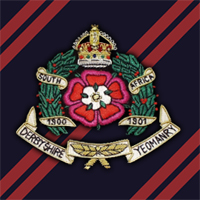
The Derbyshire Yeomanry was a yeomanry regiment of the British Army, first raised in 1794, which served as a cavalry regiment and dismounted infantry regiment in the First World War and provided two reconnaissance regiments in the Second World War, before being amalgamated with the Leicestershire Yeomanry to form the Leicestershire and Derbyshire Yeomanry in 1957.
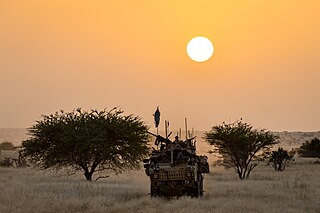
There are 13 cavalry Regiments of the British Army each with its own unique cap badge, regimental traditions, and history. Of the currently nine regular cavalry regiments, two serve as armoured regiments, three as armoured cavalry regiments, three as light cavalry, and one as a mounted ceremonial regiment. There are also four yeomanry regiments of the Army Reserve, of these, three serve as light cavalry and one as an armoured regiment. Each yeomanry light cavalry unit has been paired with a regular unit of the same role, the armoured yeomanry unit is paired with the two regular armoured units. All except the Household Cavalry are part of the British Army's Royal Armoured Corps.

The 3rd County of London Yeomanry (Sharpshooters) was a Yeomanry regiment of the British Army. It was raised in 1901 from Second Boer War veterans of the Imperial Yeomanry. During the First World War it served dismounted at Gallipoli, was remounted to serve in Macedonia, Egypt and Palestine, before being converted to machine gunners for service on the Western Front. 2nd and 3rd Line units remained in the United Kingdom throughout.

The Northumberland Hussars was a Yeomanry regiment of the British Army, transferred to the Royal Artillery for the duration of the Second World War. It was disbanded as an independent Territorial Army unit in 1967, a time when the strength of the Territorial Army was greatly reduced. The regiment's name lives on in the title of the command and support squadron of the Queen's Own Yeomanry (QOY), a Formation Reconnaissance Regiment based in Newcastle upon Tyne.
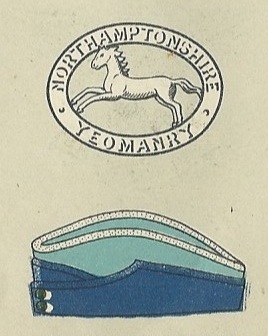
The Northamptonshire Yeomanry was a Yeomanry regiment of the British Army, formed in 1794 as volunteer cavalry. It served in the Second Boer War, the First World War and the Second World War before being reduced to squadron level in 1956. It ceased to have a separate existence in 1971.
Armoured regiments are units provided by the Royal Armoured Corps of the British Army.
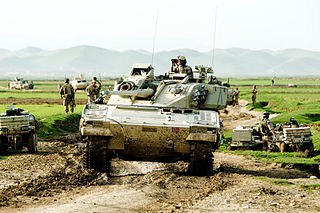
Armoured reconnaissance is the combination of terrestrial reconnaissance with armoured warfare by soldiers using tanks and wheeled or tracked armoured reconnaissance vehicles. While the mission of reconnaissance is to gather intelligence about the enemy with the use of reconnaissance vehicles, armoured reconnaissance adds the ability to fight for information, and to have an effect on and to shape the enemy through the performance of traditional armoured tasks.
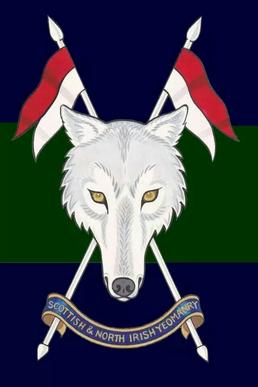
The Scottish and North Irish Yeomanry (SNIY) is a reserve light cavalry regiment created in 2014 as part of the restructuring of the British Army's Army Reserve. It is operationally paired with the Royal Scots Dragoon Guards, based at Leuchars Station in Fife, Scotland. The regiment has numerous squadrons across Scotland and Northern Ireland.

The page contains the current structure of the British Army. The British Army is currently being reorganised to the Future Soldier structure.


























